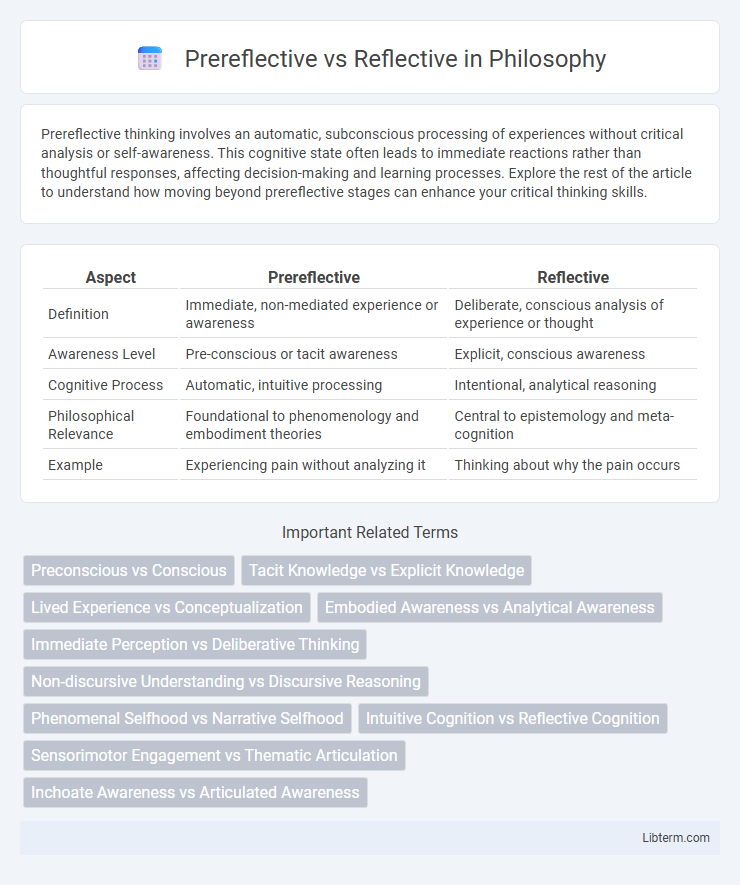Prereflective thinking involves an automatic, subconscious processing of experiences without critical analysis or self-awareness. This cognitive state often leads to immediate reactions rather than thoughtful responses, affecting decision-making and learning processes. Explore the rest of the article to understand how moving beyond prereflective stages can enhance your critical thinking skills.
Table of Comparison
| Aspect | Prereflective | Reflective |
|---|---|---|
| Definition | Immediate, non-mediated experience or awareness | Deliberate, conscious analysis of experience or thought |
| Awareness Level | Pre-conscious or tacit awareness | Explicit, conscious awareness |
| Cognitive Process | Automatic, intuitive processing | Intentional, analytical reasoning |
| Philosophical Relevance | Foundational to phenomenology and embodiment theories | Central to epistemology and meta-cognition |
| Example | Experiencing pain without analyzing it | Thinking about why the pain occurs |
Introduction to Prereflective and Reflective Thinking
Prereflective thinking involves immediate, intuitive cognitive processes where individuals accept knowledge based on authority or perception without critical analysis. Reflective thinking, in contrast, engages deeper examination, allowing individuals to evaluate evidence, consider multiple perspectives, and develop reasoned conclusions. Understanding the distinction between prereflective and reflective thinking is essential in cognitive development, educational strategies, and decision-making frameworks.
Defining Prereflective Consciousness
Prereflective consciousness refers to the immediate, non-thematic awareness of experiences, characterized by a direct, implicit presence to sensory or mental states without active self-reflection. It underpins the pre-reflective self-awareness inherent in lived experience, where one's consciousness is transparent and engaged without explicit introspection. Understanding prereflective consciousness is crucial for distinguishing it from reflective consciousness, which involves deliberate and conceptual thinking about one's own mental states.
Understanding Reflective Awareness
Reflective awareness involves actively examining and questioning one's own thoughts, feelings, and experiences, enabling deeper self-understanding and learning. Unlike prereflective awareness, which is immediate and non-analytical, reflective awareness supports critical thinking and conscious decision-making by fostering meta-cognition. Developing reflective awareness enhances emotional intelligence, problem-solving skills, and the ability to adapt perspectives in complex situations.
Key Differences Between Prereflective and Reflective
Prereflective knowledge involves immediate, non-thematic awareness of experiences without explicit self-analysis, while reflective knowledge requires deliberate thought and evaluation of one's experiences or beliefs. Key differences include the level of consciousness, with prereflective being automatic and implicit, and reflective being intentional and explicit. Prereflective cognition often influences behavior subconsciously, whereas reflective cognition enables critical thinking and conscious decision-making.
Psychological Foundations of Reflection
Prereflective knowledge relies on immediate, non-critical awareness often based on direct experience without questioning underlying assumptions, while reflective knowledge involves deliberate evaluation and analysis of thoughts, beliefs, and experiences. The psychological foundations of reflection highlight metacognition, where individuals monitor and regulate their cognitive processes to develop deeper understanding and critical thinking. This distinction underscores the transition from implicit understanding to explicit, conscious reasoning essential in self-regulated learning and adaptive problem-solving.
Prereflective Experience in Daily Life
Prereflective experience in daily life involves automatic, immediate awareness without conscious analysis, such as recognizing a friend's face or feeling the warmth of sunlight instinctively. This type of experience operates beneath reflective thought, relying on direct perception and embodied knowledge to navigate the world efficiently. Prereflective awareness shapes routine actions and interactions by grounding cognition in present-moment sensory and emotional states before deliberate reflection occurs.
Role of Reflection in Decision Making
Prereflective decision making relies on intuition and immediate perceptions without conscious analysis, often leading to automatic or habitual responses. Reflective decision making involves deliberate evaluation and critical thinking, allowing individuals to consider alternatives, consequences, and underlying assumptions before choosing an action. The role of reflection enhances decision quality by encouraging deeper understanding, reducing cognitive biases, and fostering adaptive problem-solving strategies.
Prereflective vs Reflective in Phenomenology
Prereflective self-awareness in phenomenology refers to the immediate, non-thematic experience of being conscious without explicit self-reflection, serving as the foundational layer of subjectivity. Reflective self-awareness involves the deliberate turning of attention toward oneself as an object, enabling critical analysis and explicit self-knowledge. This distinction underscores the primacy of prereflective experience as the implicit background from which reflective thought emerges in phenomenological inquiry.
Practical Implications in Education and Therapy
Prereflective thinking, characterized by automatic, intuitive responses, limits critical self-awareness, while reflective thinking enables deliberate analysis and deeper understanding of experiences, crucial for personalized learning and therapeutic progress. In education, fostering reflective thinking enhances metacognitive skills, promoting adaptive problem-solving and lifelong learning abilities. Therapeutically, encouraging clients to shift from prereflective to reflective awareness improves emotional regulation and insight, facilitating more effective treatment outcomes.
Conclusion: Integrating Prereflective and Reflective Practices
Integrating prereflective and reflective practices enhances decision-making by combining intuitive, fast judgments with deliberate, analytical thinking. This synergy leverages the strengths of both automatic responses and conscious evaluation, leading to improved problem-solving and learning outcomes. Emphasizing a balance between these modes fosters adaptive expertise across various contexts.
Prereflective Infographic

 libterm.com
libterm.com